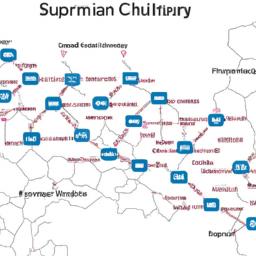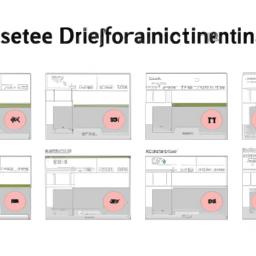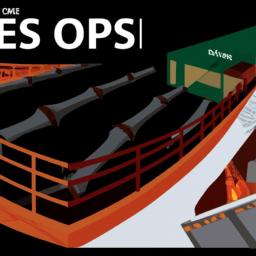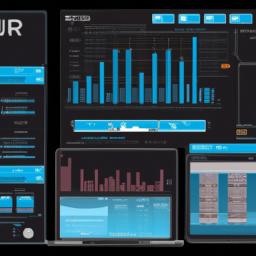Distribution ERP Software Features: Streamlining Your Business Operations
Introduction to Distribution ERP Software Features

In this digital age, businesses are constantly seeking innovative ways to streamline their operations and gain a competitive edge. One such solution that has revolutionized the way companies manage their inventory, sales, and supply chain processes is Distribution ERP software. But what exactly is Distribution ERP software, and why is it so crucial in today’s business landscape?
Distribution ERP software, or Enterprise Resource Planning software, is a comprehensive system that integrates various essential functions of a distribution business into one centralized platform. This software not only helps in managing inventory but also plays a vital role in optimizing sales processes and orchestrating the entire supply chain.
Imagine having a virtual assistant that keeps track of your inventory levels, automates order processing, and provides real-time visibility into your supply chain. With Distribution ERP software, you can do just that, and more. This powerful tool acts as a catalyst for efficiency and growth, empowering businesses to make informed decisions, maximize profits, and deliver exceptional customer experiences.
One of the primary benefits of Distribution ERP software is its ability to streamline inventory management. It allows businesses to track and manage inventory levels effectively, reducing stockouts and minimizing excess stock. By optimizing order fulfillment and ensuring prompt deliveries, businesses can enhance customer satisfaction and loyalty.
Furthermore, Distribution ERP software simplifies the order management process. It automates order entry, eliminating manual errors and reducing processing time. With features like real-time order tracking and accurate order data, businesses can manage their sales pipeline more efficiently, enabling them to focus on delivering exceptional service and driving revenue growth.
The role of Distribution ERP software extends beyond inventory and order management. It encompasses various aspects of the supply chain, from procurement to delivery. By providing real-time visibility into the entire supply chain, businesses can identify bottlenecks, optimize workflows, and ensure smooth operations. This holistic approach to supply chain management helps businesses make data-driven decisions, reduce costs, and improve overall efficiency.
In conclusion, Distribution ERP software is a game-changer for businesses in the distribution industry. It streamlines operations, enhances visibility, and empowers businesses to make informed decisions. In the following sections, we will delve deeper into the key features of Distribution ERP software, the benefits it offers, and the considerations for selecting the right software for your business. So, let’s dive in and explore the world of Distribution ERP software together!
Key Features of Distribution ERP Software
In the fast-paced world of distribution, efficiency and accuracy are paramount. Distribution ERP software offers a wide range of features that empower businesses to streamline their operations and stay ahead of the competition. Let’s explore some of the key features that make Distribution ERP software a game-changer for businesses in this industry.
Inventory Management
Inventory is the lifeblood of distribution businesses, and effective inventory management is essential for success. Distribution ERP software provides robust inventory management capabilities, allowing businesses to track and manage inventory levels in real-time. With accurate visibility into stock levels, businesses can optimize order fulfillment, reduce stockouts, and minimize excess inventory. By automating inventory control processes, Distribution ERP software enables businesses to maintain optimal inventory levels, ensuring that products are available when customers need them.
Order Management
Efficient order processing is crucial for customer satisfaction and revenue growth. Distribution ERP software streamlines the entire order management process, from order entry to fulfillment. By automating order entry, businesses can eliminate manual errors and accelerate the order processing cycle. Real-time order tracking allows businesses to provide accurate delivery information to customers and proactively address any issues that may arise. With improved order accuracy and faster processing times, businesses can enhance customer experiences and drive repeat business.
Supply Chain Management
The success of a distribution business heavily relies on the efficiency of its supply chain. Distribution ERP software provides comprehensive supply chain management capabilities, enabling businesses to monitor and optimize every step of the supply chain. From procurement to delivery, businesses can gain real-time visibility into inventory, shipments, and supplier performance. By identifying bottlenecks and optimizing workflows, businesses can ensure smooth operations, reduce costs, and improve overall efficiency.
Sales Management
Distribution ERP software offers robust sales management features that empower businesses to drive revenue growth. From lead management to quotation generation and sales forecasting, businesses can effectively manage and track their sales pipeline. By centralizing customer data and providing sales teams with real-time insights, Distribution ERP software helps businesses identify sales opportunities, nurture leads, and close deals faster. With a 360-degree view of the sales process, businesses can make data-driven decisions and maximize sales performance.
Reporting and Analytics
Data-driven decision making is essential for staying competitive in the distribution industry. Distribution ERP software provides powerful reporting and analytics capabilities, allowing businesses to gain valuable insights into their operations. Customizable reports and dashboards enable businesses to monitor key performance indicators, track trends, and identify areas for improvement. With real-time data at their fingertips, businesses can make informed decisions, optimize processes, and drive continuous improvement.
Integration and Scalability
As businesses grow, their software needs to grow with them. Distribution ERP software offers seamless integration capabilities, allowing businesses to connect with other systems such as CRM or e-commerce platforms. This integration eliminates data silos and enables smooth data flow across the organization. Additionally, Distribution ERP software is scalable, meaning it can accommodate the changing needs of a growing business. Whether it’s adding new users, expanding to new locations, or integrating with third-party applications, Distribution ERP software provides the flexibility to support business growth.
In the next sections, we will explore the benefits of using Distribution ERP software, considerations for choosing the right software, and best practices for implementation. So, let’s continue our journey into the world of Distribution ERP software and discover how it can transform your business!
Considerations for Choosing Distribution ERP Software
Choosing the right Distribution ERP software is a critical decision that can significantly impact your business’s efficiency and success. With numerous options available in the market, it’s essential to consider several factors to ensure you select a software solution that aligns with your business needs and future growth. Let’s explore the key considerations when choosing Distribution ERP software.
Business Needs Assessment
Before diving into the vast sea of software options, it is crucial to conduct a thorough assessment of your business requirements and processes. Understanding your specific needs and pain points will help you identify the features and functionalities necessary for your Distribution ERP software. Consider questions such as: How complex are your inventory management processes? Do you require advanced reporting and analytics capabilities? By evaluating your business needs, you can narrow down your options and focus on software solutions that meet your specific requirements.
Customization and Flexibility
Every business is unique, and your Distribution ERP software should be able to adapt to your specific workflows and processes. Look for a software solution that offers customization options, allowing you to tailor the system to your business’s unique requirements. Flexibility is also key, as it ensures that the software can scale alongside your business as it grows and evolves. Whether it’s configuring workflows, adding new modules, or integrating with other systems, a customizable and flexible Distribution ERP software will provide the agility your business needs.
Ease of Use and Training
Implementing a new software system requires a smooth transition and user adoption. Opt for a Distribution ERP software that offers a user-friendly interface and intuitive navigation, making it easy for your employees to learn and use the system effectively. Additionally, comprehensive training programs and resources provided by the software vendor can facilitate a successful implementation. Ensure that the software vendor offers training sessions, documentation, and ongoing support to help your team fully utilize the software’s capabilities.
Vendor Support and Reputation
When selecting a Distribution ERP software, it’s essential to choose a reputable vendor with a strong customer support system. Research the vendor’s reputation in the industry, read customer reviews, and assess their track record of delivering quality software and reliable support. A vendor with excellent customer support will be responsive to your queries and provide timely assistance when needed. By selecting a reputable vendor, you can have peace of mind knowing that you have a reliable partner to support your business’s growth and success.
In conclusion, selecting the right Distribution ERP software requires careful consideration of your business needs, customization options, ease of use, and vendor support. By evaluating these factors, you can choose a software solution that aligns with your business goals and empowers you to streamline your operations effectively. In the following sections, we will explore implementation best practices and delve deeper into the features and benefits of Distribution ERP software. So, let’s continue our journey towards optimizing your business processes!
Implementation Best Practices for Distribution ERP Software
Implementing a distribution ERP software solution is a significant undertaking for any business. To ensure a successful implementation and maximize the benefits of the software, it is crucial to follow best practices throughout the process. Let’s explore some key considerations and strategies for a smooth and effective implementation.
Project Planning
Thorough project planning is the foundation of a successful distribution ERP software implementation. It involves defining clear goals, assembling a dedicated implementation team, and establishing realistic timelines. By setting specific objectives and milestones, businesses can stay on track and ensure that the implementation aligns with their overall business strategy.
Engaging key stakeholders, including employees from various departments, is essential during the planning phase. Their input and insights will help identify specific pain points, requirements, and desired outcomes. This collaborative approach fosters ownership and buy-in from the team, increasing the chances of a successful implementation.
Data Migration
Migrating data from legacy systems to the new distribution ERP software can be a complex process. It is crucial to ensure the accuracy and integrity of the data during the migration to avoid any disruptions or inconsistencies in operations. Identifying and cleaning up any data inconsistencies or duplicates beforehand is vital for a smooth transition.
Businesses should also consider mapping data from their existing systems to the corresponding fields in the new distribution ERP software. This mapping process ensures that the data is correctly transferred and can be seamlessly integrated into the new system. Regular data backups and validation checks throughout the migration process are essential to minimize the risk of data loss or corruption.
Training and Change Management
Comprehensive training programs are critical for successful adoption of the distribution ERP software. Employees need to understand how to use the software effectively to maximize its benefits. Training sessions should be tailored to different user roles and should cover all relevant functionalities and workflows.
Change management strategies are equally vital to facilitate a smooth transition and minimize resistance to change. Effective communication, transparency, and ongoing support are key elements of change management. By involving employees early in the process, addressing their concerns, and providing continuous support, businesses can foster a positive mindset towards the new software and ensure its successful adoption.
Ongoing Support and Maintenance
Once the distribution ERP software is implemented, businesses should ensure ongoing support from the vendor. This support includes software updates, bug fixes, and technical assistance when needed. Regular communication with the vendor and staying up-to-date with the latest software enhancements are essential for maximizing the benefits of the distribution ERP software.
Moreover, businesses should establish a culture of continuous improvement. Regularly evaluating the software’s performance, gathering feedback from users, and identifying areas for enhancement will help optimize operations and ensure that the software continues to meet evolving business needs.
By following these implementation best practices, businesses can successfully implement a distribution ERP software solution and leverage its full potential to streamline operations, enhance efficiency, and drive business growth. The next section will conclude our exploration of distribution ERP software and highlight its significance in today’s competitive business landscape.





